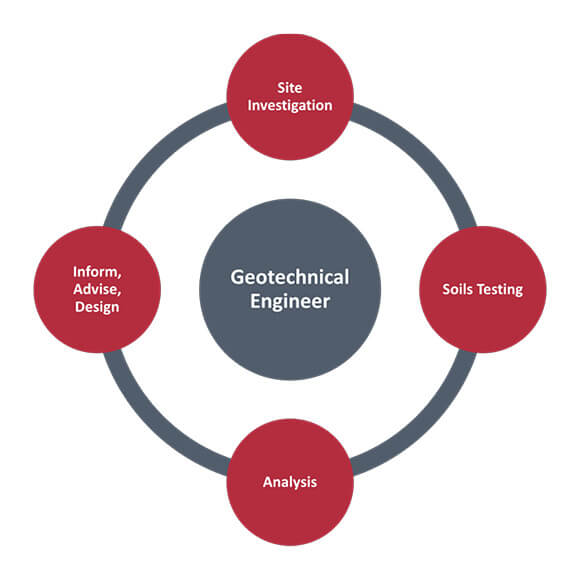The Main Principles Of Geotheta
The Main Principles Of Geotheta
Blog Article
Not known Facts About Geotheta
Table of ContentsThe Single Strategy To Use For GeothetaThe Basic Principles Of Geotheta The Of GeothetaThe Of GeothetaA Biased View of Geotheta

They perform site investigations, gather samples, do research laboratory tests, and assess data to examine the suitability of the ground for construction projects - Geotechnical Engineers. Based on their findings, geotechnical designers supply referrals for structure layout, incline security, maintaining frameworks, and reduction of geotechnical threats. They team up with various other specialists, such as designers, structural engineers, and construction groups, to make certain that geotechnical factors to consider are incorporated right into the general job design and implementation
By assessing the behavior and properties of soil and rock, they can identify potential geotechnical hazards such as landslides, dirt settlement, or incline instability. Their know-how assists avoid failings or accidents that can threaten lives and residential property. Here are some in-depth obligations and obligations of a geotechnical engineer: Website Investigation: Geotechnical designers conduct site investigations to collect data on subsurface problems.
They analyze the information to recognize the residential properties and behavior of the soil and rock, including their toughness, leaks in the structure, compaction attributes, and groundwater problems. Geotechnical Analysis and Design: Geotechnical designers assess the information accumulated during website examinations to assess the security and suitability of the website for building tasks. They execute geotechnical computations and modeling to review aspects such as bearing ability, negotiation, slope stability, side earth pressures, and groundwater circulation.
What Does Geotheta Mean?
Foundation Layout: Geotechnical engineers play a critical function in creating foundations that can securely support the designated structure. They analyze the soil conditions and load demands to establish the proper foundation type, such as superficial foundations (e.g., footings), deep foundations (e.g (https://flossy-rotate-3d1.notion.site/Why-Geotechnical-Engineers-are-Vital-for-Your-Construction-Projects-7c147cf012a34d1abe5134afbabc811f?pvs=4)., piles), or specialized techniques like dirt enhancement. They think about elements such as negotiation restrictions, bearing ability, and soil-structure interaction to create optimum foundation designs
They assess construction strategies, screen website activities, and perform area assessments to verify that the design recommendations are complied with. If unexpected geotechnical concerns develop, they assess the situation and give suggestions for remediation or changes to the style. Danger Analysis and Mitigation: Geotechnical engineers assess geotechnical threats and risks connected with the job site, such as landslides, liquefaction, or soil disintegration.

Partnership and Communication: Geotechnical designers work very closely with other professionals associated with a project, such as designers, structural designers, and building and construction groups. Effective interaction and collaboration are crucial to integrate geotechnical factors to consider right into the overall job style and construction process. Geotechnical designers provide technological competence, solution inquiries, and make certain that geotechnical requirements are satisfied.
How Geotheta can Save You Time, Stress, and Money.
Below are some kinds of geotechnical engineers: Foundation Designer: Structure designers concentrate on creating and assessing structures for structures. They evaluate the dirt problems, tons demands, and website characteristics to identify the most proper structure kind and style, such as superficial structures, deep foundations, or specialized techniques like pile structures.
They evaluate the factors influencing slope stability, such as soil buildings, groundwater problems, and slope geometry, and establish techniques to stop incline failures and minimize threats. Earthquake Engineer: Earthquake engineers focus on evaluating and developing frameworks to hold up against seismic pressures. They assess the seismic hazard of a website, examine dirt liquefaction possibility, and establish seismic design criteria to make certain the safety and resilience of frameworks during quakes.
They carry out field testing, collect examples, and analyze the accumulated data to characterize the dirt homes, geologic formations, and groundwater problems at a site. Geotechnical Instrumentation Designer: Geotechnical instrumentation designers concentrate on surveillance and determining the behavior of dirt, rock, and frameworks. They set up and maintain instrumentation systems that check variables such as soil settlement, groundwater degrees, slope activities, and architectural displacements to analyze efficiency and offer very early warnings of prospective issues.
What Does Geotheta Mean?
They carry out examinations such as triaxial tests, combination examinations, straight shear tests, and leaks in the structure examinations to gather data for geotechnical analysis and style. Geosynthetics Designer: Geosynthetics designers specialize in the style and application of geosynthetic products, such as geotextiles, geogrids, check my blog and geomembranes. They use these materials to boost soil stability, reinforce slopes, supply drain remedies, and control disintegration.
They tend to be investigatory people, which suggests they're intellectual, reflective, and inquisitive. They are curious, methodical, rational, analytical, and sensible. Some of them are additionally social, suggesting they're kind, charitable, cooperative, patient, caring, useful, empathetic, tactful, and friendly - Consulting Engineer.
In the office setting, geotechnical engineers utilize specialized software application tools to execute calculations, develop styles, and assess information. They prepare reports, review job specifications, connect with clients and employee, and coordinate project tasks. The office setup offers a helpful atmosphere for research, evaluation, and collaboration with various other experts associated with the job.
Our Geotheta Statements
They often see job websites to perform site examinations, analyze geotechnical conditions, and gather data for evaluation. These gos to include taking a trip to different places, occasionally in remote or challenging terrains. Geotechnical designers might perform soil tasting, conduct tests, and monitor building tasks to ensure that the geotechnical aspects of the job are being carried out correctly.
Geotechnical designers additionally work in specialized geotechnical labs. In these centers, they conduct experiments, carry out tests on soil and rock samples, and examine the design homes of the materials. Geotechnical lab engineers function thoroughly in these atmospheres, taking care of testing tools, operating tools, and tape-recording data. They collaborate with other laboratory staff to make sure precise and trustworthy screening outcomes.
Report this page